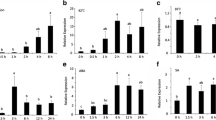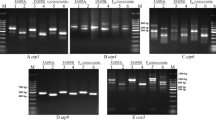Abstract
The Me1 gene of Flaveria bidentis codes for the C4 isoform of NADP malic enzyme, which accumulates to a high-level only in bundle sheath cells. Previous experiments demonstrated that sequences at the 5′ end of the gene control cell specificity whereas sequences at the 3′ end are necessary for high-level expression. To localize quantitative regulator sequences, we have analysed a series of Me1 3′ deletion constructs fused to the gusA reporter gene. We show that sequences within the 3′-untranslated region (3′-UTR) control quantitative levels of expression. Analysis of 5′ promoter fusions demonstrated that high-level expression also requires sequences within the N-terminal coding region of the gene, suggesting possible interactions between the 3′-UTR and 5′ coding regions. Cell-specific regulatory sequences are located in a different part of the 5′ end of the gene, between 1023 bp upstream of the transcription start and the start of translation.
Similar content being viewed by others
References
Agostino, A., Furbank, R.T. and Hatch, M.D. 1989. Maximizing photosynthetic activity and cell integrity in isolated bundle sheath cell strands from C4 species. Aust. J. Plant Physiol. 16: 279–290.
Ali, S. and Taylor, W.C. 2001. The 3′ non-coding region of a C4 photosynthesis gene increases transgene expression when combined with heterologous promoters. Plant Mol. Biol. 6: 325–333.
An, G. 1987. Binary Ti vectors for plant transformation and promoter analysis. Meth. Enzymol. 153: 292–305.
Berry, J.O., McCormac, D.J., Long, J.J., Boinski, J. and Corey, A.C. 1997. Photosynthetic gene expression in amaranth, an NAD-ME type C4 dicot. Aust. J. Plant Physiol. 24: 423–428.
Binder, R., Horowitz, J.A., Basilion, J.P., Koeller, D.M., Klausner, R.D. and Harford, J.B. 1994. Evidence that the pathway of transferrin receptor mRNA degradation involves an endonucleolytic cleavage within the 3′ UTR and does not involve poly(A) tail shortening. EMBO J. 13: 1969–1980.
Bodine, D.M., and Ley, T.J. 1987. An enhancer element lies 3′ to the human γ-globin gene. EMBO J. 6: 2997–3004.
Borsch, D., and Westhoff, P. 1990. Primary structure of NADP-dependent malic enzyme in the dycotyledonous C4 plant Flaveria trinervia. FEBS Lett. 273: 111–115.
Burgess, D.G. and Taylor, W.C. 1987. Chloroplast photooxidation affects the accumulation of cytosolic mRNAs encoding chloroplast proteins in maize. Planta 170: 520–527.
Chen, R., Silver, D.L. and de Bruijn, E.J. 1998. Nodule parenchyma-specific expression of the Sesbania rostrata early nodulation gene SrEnod2 is mediated by 3′-untranslated region. Plant Cell 10: 1585–1602.
Chitty, J.A., Furbank, R.T., Marshall, J.S., Chen, Z. and Taylor, W.C. 1994. Genetic transformation of the C4 plant, Flaveria bidentis. Plant J. 6: 949–956.
Choi, O.R. and Engel, J.D. 1986. A 3′ enhancer is required for temporal and tissue specific transcriptional activation of the chicken adult β-globin gene. Nature 323: 731–734.
Daniel, S.G. and Becker, W.M. 1995. Transgenic analysis of the 5′ and 3′ flanking regions of the NADH-dependent hydroxypyruvate reductase gene from Cucumis sativus L. Plant Mol. Biol. 28: 821–836.
Dean, C., Favreau, M., Bond-Nutter, D., Bedbrook, J. and Dunsmuir, P. 1989. Sequences downstream of translation start regulate quantitative expression of two petunia RbcS genes. Plant Cell 1: 201–208.
Dengler, N.G. and Taylor, W.C. 2000. Developmental aspects of C4 photosynthesis. In: R.C. Leegood, T.D. Sharkey and S. von Caemmerer (Eds.) Photosynthesis: Physiology and Metabolism, Kluwer Acdemic Publishers, Dordrecht, Netherlands, pp. 471–495.
Dietrich, R.A., Radke, S.E. and Harada, J.J. 1992. Downstream DNA sequences are required to activate a gene expressed in the root cortex of embryos and seedlings. Plant Cell 4: 1371–1382.
Fagard, M. and Vaucheret, H. 2000. (Trans) gene silencing in plants: how many mechanisms? Annu. Rev. Plant Physiol. Plant Mol. Biol. 51: 167–194.
Fu, H., Kim, S.Y. and Park, W.D. 1995a. High-level tuber expression and sucrose inducibility of a potato Sus4 sucrose synthase gene requires 5′ and 3′ flanking sequences and the leader intron. Plant Cell 7: 1387–1394.
Fu, H., Kim, S.Y. and Park, W.D. 1995b. A potato Sus3 sucrose synthase gene contains a context-dependent 3′ element and a leader intron with both positive and negative tissue specific effects. Plant Cell 7: 1395–1403.
Hatch, M.D. 1987. C4 photosynthesis: a unique blend of modified biochemistry, anatomy and ultrastructure. Biochim. Biophys. Acta 895: 81–106.
Janssen, B. and Gardner, R.C. 1989. Localised transient expression of GUS in leaf discs following cocultivation with Agrobacterium. Plant Mol. Biol. 14: 61–72.
Jefferson, R. 1987. Assaying chimeric genes in plants. The GUS gene fusion system. Plant Mol. Biol. Rep. 5: 387–405.
Larkin, J.C., Oppenheimer, D.G., Pollock, S. and Marks, M.D. 1993. Arabidopsis GLABROUS1 gene requires downstream sequences for function. Plant Cell 5: 1739–1748.
Lauridsen, P., Franssen, H., Stougaard, J., Bisseling, T. and Marker, K.H. 1993. Conserved regulation of soybean early nodulation ENOD2 gene promoter in determinate and indeterminate transgenic root nodules. Plant J. 3: 483–492.
Long, J.J. and Berry, J.O. 1996. Tissue-specific and light-mediated expression of the C4 photosynthetic NAD-dependent malic enzyme of amaranth mitochondria. Plant Physiol. 112: 473–482.
Marshall, J.S., Stubbs, J.D. and Taylor, W.C. 1996. Two genes encode highly similar chloroplastic NADP-malic enzymes in Flaveria. Plant Physiol. 111: 1251–1261.
Marshall, J.S., Stubbs, J.D., Chitty, J.A., Surin, B. and Taylor, W.C. 1997. Expression of the C4 Me1 gene from Flaveria bidentis requires an interaction between 5′ and 3′ sequences. Plant Cell 9: 1515–1525.
Matsuoka, M., Kyozuka, J., Shimamoto, K. and Kano-Murakami, Y. 1994. Promoters of two carboxylases in a C4 plant (maize) direct cell specific, light-regulated expression in a C3 plant (rice). Plant J. 6: 311–319.
Matsuoka, M. and Numazawa, T. 1991. Cis acting elements in the pyruvate, orthophosphate dikinase gene from maize. Mol. Gen. Genet. 228: 143–152.
Matsuoka, M. and Sanada, Y. 1991. Expression of photosynthetic genes from the C4 plant, maize, in tobacco. Mol. Gen. Genet. 225: 411–419.
Matsuoka, M., Tada, Y., Fujimura, T. and Kano-Murakami, Y. 1993. Tissue-specific light regulated expression directed by the promoter of a C4 gene, maize pyruvate,orthophosphate dikinase, in a C3 plant, rice. Proc. Natl. Acad. Sci. USA 90: 9586–9590.
Owen, D. and Kuhn, L.C. 1987. Non-coding 3′ sequences of the transferrin receptor gene are required for mRNA regulation by iron. EMBO J. 6: 1287–1293.
Ramsperger, V.C., Summers, R.G. and Berry, J.O. 1996. Photosynthetic gene expression in meristems and during initial leaf development in a C4 dicotyledonous plant. Plant Physiol. 111: 999–1010.
Sambrook, J., Fritsch, E.F. and Maniatis, T. 1989. Molecular Cloning: A Laboratory Manual, 2nd ed. Cold Spring Harbor Laboratory Press, Plainview, NY.
Sheen, J. 1999. C4 gene expression. Annu. Rev. Plant Physiol. Plant Mol. Biol. 50: 187–217.
Smicun, Y., Kopf, E. and Miskin, R. 1998. The 3′-untranslated region of the urokinase gene enhances the expression of chimeric genes in cultured cells and correlates with specific brain expression in transgenic mice. Eur. J. Biochem. 251: 704–715.
Stockhaus, J., Poetsch, W., Steinmuller, K. and Westhoff, P. 1994. Evolution of the C4 phosphoenolpyruvate carboxylase promoter of the C4 dicot Flaveria trinervia: an expression analysis in the C3 plant tobacco. Mol. Gen. Genet. 245: 286–293.
Stockhaus, J., Schlue, U., Koczor, M., Chitty, J.A., Taylor, W.C. and Westhoff, P. 1997. The promoter of the gene encoding the C4 form of phosphoenolpyruvate carboxylase directs mesophyll-specific expression in trangenic C4 Flaveria spp. Plant Cell 9: 479–489.
Tarun, S.Z. and Sachs, A.B. 1996. Association of the yeast poly(A) tail binding protein with translation initiation factor eIF-4G. EMBO J. 15: 7168–7177.
Taylor, W.C., Rosche, E., Marshall, J.S., Ali, S., Chastain, C.J. and Chitty, J.A. 1997. Diverse mechanisms regulate the expression of genes coding C4 enzymes. Aust. J. Plant Physiol. 24: 437–442.
Thornburg, R.W., An, G., Cleaveland, T.E., Johnson, R. and Ryan, C.A. 1987. Wound-inducible expression of a potato inhibitor II-chloramphenicol acetyltransferase gene fusion in transgenic potato plants. Proc. Natl. Acad. Sci. USA 84: 744–748.
Trainor, C.D., Stamler, S.J. and Engel, J.D. 1987. Erythroid-specific transcription of the chicken histone H5 gene is directed by a 3′ enhancer. Nature 328: 827–830.
Viret, J.F., Mabrouk, Y. and Bogorad, L. 1994. Transcriptional photoregulation of cell-type-preferred expression of maize rbcS-m3: 3′ and 5′ sequences are involved. Proc. Natl. Acad. Sci. USA 91: 8577–8581.
Wang, J.L., Klessig, D.F. and Berry, J.O. 1992. Regulation of C4 gene expression in developing amaranth leaves. Plant Cell 4: 173–184.
Weiss, I.M. and Liebhaber, S.A. 1995. Erythroid cell-specific mRNA stability elements in the α2-globin 3′ nontranslated region. Mol. Cell Biol. 15: 2457–2465.
Author information
Authors and Affiliations
Rights and permissions
About this article
Cite this article
Ali, S., Taylor, W.C. Quantitative regulation of the Flaveria Me1 gene is controlled by the 3′-untranslated region and sequences near the amino terminus. Plant Mol Biol 46, 251–261 (2001). https://doi.org/10.1023/A:1010684509008
Issue Date:
DOI: https://doi.org/10.1023/A:1010684509008




